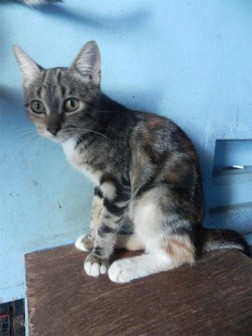 Last week we dealt with paralyses that have their origin in congenital (birth) defects.Today we’ll look at the acquired, degenerative spinal cord problems, which cause paralyses. Most spinal cord damage is the result of physical injury (eg car accidents).
Last week we dealt with paralyses that have their origin in congenital (birth) defects.Today we’ll look at the acquired, degenerative spinal cord problems, which cause paralyses. Most spinal cord damage is the result of physical injury (eg car accidents).
However, tumours and even infections can be the original culprits.
We had explained that injuries to the spinal cord cause a variety of neurological consequences, of which paralysis is but one. Generally speaking, these neurological disorders exhibit themselves as weakness of the affected limbs, loss of feeling and the (worst case scenario) paralysis of the hind legs (usually) or of all four legs.
The most common spinal cord ailment comes from herniated discs (intervertebral disc disease). Note that I said herniated disc not ‘slipped disc.’ I don’t know where this concept originated that somehow the pads (discs) between the individual bones of the spinal column get slipped.

The intervertebral disc disease (herniated disc) is really a degeneration and protrusion of the inner part of the intervertebral disc, which is the cushion that sits between the individual bones of the spinal column (backbone). This results in the compression of the spinal cord (nerves).
Perhaps it would be better to graphically describe what is going on. These discs (cushions) act like shock absorbers. They are made of a rim of tough cartilage (the sort of stuff that makes up your ears) and a soft (gel-like) centre.
If the rim breaks, the inside of the disc protrudes outwards and squeezes/pinches the nerves/nerve roots of the spinal column. This tear in the tissue of the rim is like the tear in a rubber tyre, which allows the inner tube to pulp out.
When this bulge (herniation) presses against the nerves/nerve roots in the adjacent area of the spine, the result is pain and weakness of the limbs. Later, feelings are lost in the legs and full paralysis follows. Of course, if some strands of nerves (coming from the bundle in the spinal cord – that bundle which is being pressed upon by the herniated disc or some physical injury) are leading to the bladder or the rectum, then the voiding of urine and faecal matter can be severely compromised.
These described symptoms are variable and of varying intensity, because the damage is in proportion to the size of the bulge (herniation or rupture) and the area in which the hernia is taking place. On occasion more than one disc can be ruptured. This means that in several locations along the length of the spinal cord, there will be reactions (see previous paragraph).
As you can imagine, if it was a blow (mechanical trauma = physical injury) that caused the disc to herniate, then that same force might itself have damaged (swelling, haemorrhage) some nerves in the area. That would aggravate the problem.
We’ll continue with this next week.
Please implement disease preventative measures (vaccinations, routine dewormings, monthly anti-heartworm medication, etc) and adopt-a-pet from the GSPCA’s Animal Clinic and Shelter at Robb Street and Orange Walk, if you have the wherewithal to care well for the animals. Do not stray your unwanted pets, take them to the GSPCA’s Clinic and Shelter instead. If you do not wish your pet to have puppies or kittens, you may exploit the GSPCA’s free spay and neutering programme. If you see anyone being cruel to an animal, or if you need any technical information, please get in touch with the Clinic and Shelter by calling 226-4237.









